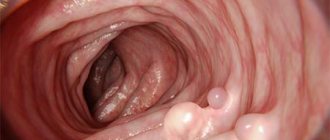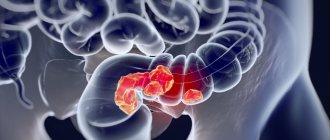Polyps in the large intestine are benign neoplasms formed from glandular epithelial cells. Normally, tissues from this type of cells line the inside of the intestine, but under the influence of certain factors they begin to grow uncontrollably, forming single or multiple mushroom-shaped, spherical or branched outgrowths directed into the intestinal lumen. In the international classification of diseases ICD-10, colon polyps are designated by code K63.5. (colon polyps).
Most often, the pathology is diagnosed in men and women of the older age category. The greatest surge in incidence is observed after overcoming the 60-year mark. In childhood, polyps are found more often in boys aged 3 to 6 years (in 80% of cases), and most often neoplasms are localized in the distal intestine.
The main danger of polyps in the large intestine is the high risk of malignancy (degeneration of a benign neoplasm into a malignant one). That is why, regardless of what polyps (type, shape and size) are detected, they are considered precancerous neoplasms with varying degrees of malignancy.
Types of benign intestinal tumor formations and their symptoms
Typically, a polypous formation inside the intestine is benign, forming from epithelial tissue cells and growing into the intestinal lumen. Polyps vary in size, shape, they can “stand” on a stalk or on a broad base, single, multiple (polyposis), soft texture.
Intestinal pathology in the form of polyps is usually observed in older people, overweight people, diabetics, and heavy smokers; it can also be caused by genetic mutations.
Considering the frequency of occurrence of polyps in different parts of the intestine, you can notice that most of them develop in the sections of the colon and rectum, and less in the small intestine. In the duodenum, polyps are diagnosed quite rarely (approximately 0.2% of all endoscopic examinations).
A tumor-like growth in the form of a polyp is not oncology, but over time there is a possibility of its transformation into a malignant tumor.
There are many types of polypous formations in the intestines, but among them the most common are:
- Adenomatous , which are observed in approximately 70% of older patients. It is this type of tumor formation that is more likely than others to degenerate into a low-quality tumor.
- Serrated polyps, depending on their size and location, have varying degrees of malignancy. If small formations are located in the lower region of the colon, the risk is minimal, but if the polyp is large and located in the upper region of the intestine, then the risk of malignant transformation increases.
- Inflammatory polyps are formed when intestinal pathologies such as Crohn's disease and ulcerative colitis occur. Although this type of tumor-like growth has a low percentage of degeneration into oncology, the treatment process should not be neglected.
The effectiveness of treatment of intestinal polyps abroad depends on an accurate diagnosis and determination of the type of pathology.
Complications of the disease
In patients who ignore the signs of the disease, colon polyps can provoke various complications:
- intestinal bleeding;
- intestinal obstruction;
- severe forms of anemia.
The most dangerous complication of colon polyposis is colorectal cancer. This disease poses a serious threat to the patient’s life and requires complex combined treatment - surgery, chemotherapy, and radiation therapy.
About the risks of colorectal cancer and the importance of timely diagnosis of colon polyps, watch the video:
The only complication that threatens patients who have undergone the procedure for removing polyps in the large intestine is intestinal perforation, when a hole forms in the intestinal wall at the site of polyp removal. As a result of the effusion of intestinal contents into the abdominal cavity, peritonitis may develop. Fortunately, such complications occur extremely rarely.
Symptoms of polyps in the intestines
The presence of polyps in the intestines is difficult to determine by any specific clinical signs. The degree of symptomatic manifestation depends on the volume and location in the intestine, the number of formations, their structure, the transformation process and other factors.
However, among the key symptoms that may indicate polyps in different parts of the intestine, the following manifestations should be mentioned:
- the presence of bloody and mucous discharge;
- periodic pain in the lower abdomen, cramping in nature;
- abnormal bowel function (constipation, diarrhea);
- sensation of a foreign body in the anal area with large polyps;
- fullness of the stomach, belching, nausea;
- rectal bleeding;
- changes in stool color (from dark with blood streaks to black);
- anemia due to constant intestinal bleeding.
However, when the polyp is small in size, symptoms do not appear in any way. Tumor-like growths of this nature are detected during screening, which is an integral part of the cancer treatment program abroad.
Fully or partially limited products
In the diet after removal of polyps in the intestines, foods containing a lot of coarse fiber are completely excluded: bran, vegetables, rye/whole grain bread, since they are poorly digested and injure the intestinal mucosa. It is not allowed to eat flour products, fresh bread, pastries, jam, dried fruits, sweets, as they cause fermentation in the intestines.
Fatty rich broths, fatty meats, fatty fish, any sausages, waterfowl meat, canned food, solid animal fats/cooking fats are prohibited in the diet. During the period of exacerbation, the consumption of porridges made from coarse cereals (pearl barley, barley, millet), legumes, vegetables and pasta is not allowed.
Hard-boiled and fried eggs, soups with vegetables, whole grains and pasta, whole milk, fatty sauces, spicy, salty cheeses, margarine, smoked meats, mustard, horseradish, pepper, chocolate, cakes, ice cream are excluded from the diet.
Drinks such as coffee/cocoa with milk, carbonated drinks, and alcohol are not allowed.
Table of prohibited products
| Proteins, g | Fats, g | Carbohydrates, g | Calories, kcal | |
Vegetables and greens | ||||
| vegetables | 2,5 | 0,3 | 7,0 | 35 |
| vegetables legumes | 9,1 | 1,6 | 27,0 | 168 |
| canned vegetables | 1,5 | 0,2 | 5,5 | 30 |
| swede | 1,2 | 0,1 | 7,7 | 37 |
| parsnip | 1,4 | 0,5 | 9,2 | 47 |
| parsley (root) | 1,5 | 0,6 | 10,1 | 49 |
| radish | 1,2 | 0,1 | 3,4 | 19 |
| turnip | 1,5 | 0,1 | 6,2 | 30 |
| celery | 0,9 | 0,1 | 2,1 | 12 |
| horseradish | 3,2 | 0,4 | 10,5 | 56 |
| garlic | 6,5 | 0,5 | 29,9 | 143 |
| spinach | 2,9 | 0,3 | 2,0 | 22 |
| sorrel | 1,5 | 0,3 | 2,9 | 19 |
Fruits | ||||
| melon | 0,6 | 0,3 | 7,4 | 33 |
Berries | ||||
| grape | 0,6 | 0,2 | 16,8 | 65 |
Mushrooms | ||||
| mushrooms | 3,5 | 2,0 | 2,5 | 30 |
Nuts and dried fruits | ||||
| dried fruits | 2,3 | 0,6 | 68,2 | 286 |
Cereals and porridges | ||||
| pearl barley | 9,3 | 1,1 | 73,7 | 320 |
| Wheat groats | 11,5 | 1,3 | 62,0 | 316 |
| millet cereal | 11,5 | 3,3 | 69,3 | 348 |
| barley grits | 10,4 | 1,3 | 66,3 | 324 |
Flour and pasta | ||||
| pasta | 10,4 | 1,1 | 69,7 | 337 |
Bakery products | ||||
| Rye bread | 6,6 | 1,2 | 34,2 | 165 |
Confectionery | ||||
| jam | 0,3 | 0,1 | 56,0 | 238 |
| candies | 4,3 | 19,8 | 67,5 | 453 |
| pastry cream | 0,2 | 26,0 | 16,5 | 300 |
| cookie | 7,5 | 11,8 | 74,9 | 417 |
| shortbread dough | 6,5 | 21,6 | 49,9 | 403 |
Ice cream | ||||
| ice cream | 3,7 | 6,9 | 22,1 | 189 |
Cakes | ||||
| cake | 4,4 | 23,4 | 45,2 | 407 |
Chocolate | ||||
| chocolate | 5,4 | 35,3 | 56,5 | 544 |
Raw materials and seasonings | ||||
| seasonings | 7,0 | 1,9 | 26,0 | 149 |
| mustard | 5,7 | 6,4 | 22,0 | 162 |
| ketchup | 1,8 | 1,0 | 22,2 | 93 |
| mayonnaise | 2,4 | 67,0 | 3,9 | 627 |
Dairy | ||||
| milk | 3,2 | 3,6 | 4,8 | 64 |
| kefir | 3,4 | 2,0 | 4,7 | 51 |
| sour cream | 2,8 | 20,0 | 3,2 | 206 |
Cheeses and cottage cheese | ||||
| cheese | 24,1 | 29,5 | 0,3 | 363 |
Meat products | ||||
| pork | 16,0 | 21,6 | 0,0 | 259 |
| ham | 22,6 | 20,9 | 0,0 | 279 |
Sausages | ||||
| dry-cured sausage | 24,1 | 38,3 | 1,0 | 455 |
| sausages | 10,1 | 31,6 | 1,9 | 332 |
| sausages | 12,3 | 25,3 | 0,0 | 277 |
Bird | ||||
| duck | 16,5 | 61,2 | 0,0 | 346 |
| goose | 16,1 | 33,3 | 0,0 | 364 |
Fish and seafood | ||||
| dried fish | 17,5 | 4,6 | 0,0 | 139 |
| smoked fish | 26,8 | 9,9 | 0,0 | 196 |
| canned fish | 17,5 | 2,0 | 0,0 | 88 |
Oils and fats | ||||
| vegetable oil | 0,0 | 99,0 | 0,0 | 899 |
| animal fat | 0,0 | 99,7 | 0,0 | 897 |
| cooking fat | 0,0 | 99,7 | 0,0 | 897 |
Non-alcoholic drinks | ||||
| bread kvass | 0,2 | 0,0 | 5,2 | 27 |
| coffee with milk and sugar | 0,7 | 1,0 | 11,2 | 58 |
| * data is per 100 g of product | ||||
Causes of intestinal polyps
It is quite problematic to unequivocally answer the question about the reasons for the appearance of polyps in the intestines. But there are factors that can lead to the formation of tumor-like growths of a benign nature, among them:
- heredity;
- elderly age;
- disorders associated with hormonal levels and metabolism in the body;
- gender (polyposis is more often diagnosed in men);
- inactive lifestyle;
- smoking;
- environmental degradation;
- poor nutrition with a predominance of foods high in fats and carbohydrates and lack of fiber in the menu;
- food allergies associated with gluten intolerance;
- chronic and inflammatory diseases of the digestive tract;
- predisposition to constipation;
- disturbances in the intestinal microflora;
- atherosclerosis.
Authorized Products
The basis of the diet after removal of polyps in the intestines is low-fat meat/fish broth and soups based on it with the addition of a small amount of pureed vegetables, egg flakes, pureed meat, or meatballs.
It is allowed to include pureed buckwheat, semolina and oatmeal, and rice (white) in the diet. All dishes are prepared by steaming or stewing. Butter is allowed to be added only to ready-made dishes (5g/serving). Dried wheat bread or white crackers (200 g/day). Dry cookies are allowed.
Lean varieties of veal, beef, chicken (without skin) or turkey are allowed. You can make meatballs or steam cutlets from minced meat. You can add boiled white rice to the cutlets/meatballs. Soft-boiled eggs or in the form of a steam omelet are allowed, up to two eggs per day. Sea fish of low-fat varieties, prepared in the form of cutlets and meatballs or in pieces.
It is allowed to include unleavened (non-acidic) freshly prepared calcined cottage cheese in mashed form into the diet. Vegetables are used only as an additive to soups. Mashed apples/applesauce are allowed in their raw form. You can prepare berry decoctions, jelly and fruit drinks from berries (blackcurrant, blueberry, dogwood, quince, pear).
It is allowed to include fresh juices from sweet berries diluted with water in the diet. As a liquid, it is recommended to use herbal tea, rosehip decoction, still water, green/black tea.
Table of permitted products
| Proteins, g | Fats, g | Carbohydrates, g | Calories, kcal | |
Vegetables and greens | ||||
| zucchini | 0,6 | 0,3 | 4,6 | 24 |
| tomatoes | 0,6 | 0,2 | 4,2 | 20 |
| pumpkin | 1,3 | 0,3 | 7,7 | 28 |
Fruits | ||||
| apricots | 0,9 | 0,1 | 10,8 | 41 |
| quince | 0,6 | 0,5 | 9,8 | 40 |
| bananas | 1,5 | 0,2 | 21,8 | 95 |
| pears | 0,4 | 0,3 | 10,9 | 42 |
| dogwood | 1,0 | 0,0 | 10,5 | 44 |
| apples | 0,4 | 0,4 | 9,8 | 47 |
Berries | ||||
| blackberry | 2,0 | 0,0 | 6,4 | 31 |
| blueberry | 1,1 | 0,4 | 7,6 | 44 |
Nuts and dried fruits | ||||
| dried pears | 2,3 | 0,6 | 62,6 | 249 |
| dried blueberries | 0,9 | 0,7 | 72,3 | 309 |
Cereals and porridges | ||||
| buckwheat (kernel) | 12,6 | 3,3 | 62,1 | 313 |
| semolina | 10,3 | 1,0 | 73,3 | 328 |
| oat groats | 12,3 | 6,1 | 59,5 | 342 |
| cereals | 11,9 | 7,2 | 69,3 | 366 |
| white rice | 6,7 | 0,7 | 78,9 | 344 |
Bakery products | ||||
| white bread crackers | 11,2 | 1,4 | 72,2 | 331 |
| doctor's bread | 8,2 | 2,6 | 46,3 | 242 |
Confectionery | ||||
| jam | 0,3 | 0,2 | 63,0 | 263 |
| jelly | 2,7 | 0,0 | 17,9 | 79 |
| marshmallows | 0,8 | 0,0 | 78,5 | 304 |
| fruit and berry marmalade | 0,4 | 0,0 | 76,6 | 293 |
| paste | 0,5 | 0,0 | 80,8 | 310 |
| oatmeal cookies | 6,5 | 14,4 | 71,8 | 437 |
Raw materials and seasonings | ||||
| honey | 0,8 | 0,0 | 81,5 | 329 |
| sugar | 0,0 | 0,0 | 99,7 | 398 |
| dried bird cherry | 8,4 | 0,0 | 16,8 | 101 |
Dairy | ||||
| acidophilus | 2,8 | 3,2 | 3,8 | 57 |
Cheeses and cottage cheese | ||||
| cottage cheese 0.6% (low fat) | 18,0 | 0,6 | 1,8 | 88 |
Meat products | ||||
| boiled beef | 25,8 | 16,8 | 0,0 | 254 |
| boiled veal | 30,7 | 0,9 | 0,0 | 131 |
| rabbit | 21,0 | 8,0 | 0,0 | 156 |
Bird | ||||
| boiled chicken | 25,2 | 7,4 | 0,0 | 170 |
| turkey | 19,2 | 0,7 | 0,0 | 84 |
Fish and seafood | ||||
| herring | 16,3 | 10,7 | — | 161 |
Oils and fats | ||||
| butter | 0,5 | 82,5 | 0,8 | 748 |
| corn oil | 0,0 | 99,9 | 0,0 | 899 |
| olive oil | 0,0 | 99,8 | 0,0 | 898 |
| sunflower oil | 0,0 | 99,9 | 0,0 | 899 |
Non-alcoholic drinks | ||||
| mineral water | 0,0 | 0,0 | 0,0 | — |
| green tea | 0,0 | 0,0 | 0,0 | — |
Juices and compotes | ||||
| carrot juice | 1,1 | 0,1 | 6,4 | 28 |
| tomato juice | 1,1 | 0,2 | 3,8 | 21 |
| rose hip juice | 0,1 | 0,0 | 17,6 | 70 |
| * data is per 100 g of product | ||||
How are intestinal polyps diagnosed abroad?
In the early stages of the development of such a pathology in the intestines, there are no pronounced symptoms, therefore, in some foreign countries, in order to most effectively prevent cancer, annual special tests have been introduced for the population. One of them, the hemocult test, makes it possible to see, using certain chemical reactions, hidden blood in the stool, which occurs even with very small polyps and may indicate more serious diseases. Timely detection of pathology in a patient helps reduce the cost of cancer treatment abroad.
Digital examination is a traditional diagnostic method when the doctor detects tumor-like growths and other pathologies in the lower parts of the intestine.
The use of MRI and CT makes it possible to observe tumor-like formations in some parts of the intestine. But to diagnose them in the rectum or sigmoid colon, it is better to undergo sigmoidoscopy. A special device, a rectoscope, helps visualize the internal walls of the organ more carefully. Doctors recommend that people who have already crossed the 50-year mark undergo such an examination at least once every 5 years.
Irrigoscopy makes it possible to see polypous formations larger than 10 mm. It is performed using a contrast agent, which is injected into the colon. Then irrigograms are performed similar to X-rays.
Today, the most informative way to diagnose polyps is still a colonoscopy. This method allows you to learn about all intestinal pathologies. When examining a polyp, a biopsy may also be performed. The removed tissue sample is immediately sent for research (histology and cytology). Such an examination also precedes the start of treatment for intestinal cancer abroad.
The use of the latest laboratory testing techniques helps to diagnose polyposis as accurately as possible and find the most effective treatment method.
Prices
| Name of service (price list incomplete) | Price |
| Appointment (examination, consultation) with a coloproctologist, primary, therapeutic and diagnostic, outpatient | 1950 rub. |
| Consultation (interpretation) with analyzes from third parties | 2250 rub. |
| Prescription of treatment regimen (for up to 1 month) | 1800 rub. |
| Prescription of treatment regimen (for a period of 1 month) | 2700 rub. |
| Consultation with a candidate of medical sciences | 2500 rub. |
| Autopsy of acute purulent paraproctitis I category of complexity | 10,000 rub. |
Treatment of intestinal polyps abroad
The most effective way to remove intestinal polyps is surgery. The desire to cure a tumor formation at home will not bring the desired results, but will only aggravate the situation, since the pathology can go into a malignant stage, and valuable time will be lost.
Nowadays, to remove polyps, they resort to a treatment method such as TAMIS (transanal minimally invasive surgery). Previously, it was first tested in cancer centers in Israel, but now high-tech equipment and qualified doctors allow this procedure to be performed quickly and painlessly in leading clinics in post-Soviet countries.
In some cases, a combined surgical intervention is used: excision of a tumor formation and electrocoagulation of small polyps. Foreign surgeons perform polypectomy on an outpatient basis using a proctoscope and an elastic ligature. In their opinion, this method is quite simple, low-traumatic, and occurs without side complications when removing even large polyps.
If malignant degeneration of a tumor-like formation in the intestine is suspected, resection of the membrane surrounding the polyp is performed. Next, the doctor sends these removed tissues for histological and cytological tests to confirm the diagnosis. This approach is actively used in the treatment of cancer in Israel and other countries.
Treatment method
Treatment of this disease involves removing polyps. One of the following methods can be used for this
- endoscopic removal (a special endoscope is used, which displays an image on the screen and is equipped with tools for cutting off the tumor; the technique is used when the pathological growth is located high);
- transanal surgery (performed through access through the anus according to the classical surgical technique with suturing the polyp at the base and cutting it off, used when the tumor is located low);
- colotomy (the operation is performed very rarely, if the tumors are large, have a wide base and are located high, access in this case is through the anterior abdominal wall, and part of the intestine with tumors is removed);
- electrocoagulation (a special instrument is inserted into the intestine, the leg of the neoplasm is burned under the influence of electric current). Source: A.A. Podberzskaya, R.M. Salmin, E.V. Mogilevets, V.A. Mitskevich, S.V. Zhdonets, Yu.F. Pakulnevich, A.G. Kalach, T.T. Rum Modern surgical methods for the treatment of colon polyposis // Journal of the Grodno State Medical University, 2016, No. 4, pp. 26-29
Sometimes the techniques are combined, depending on the type and extent of the disease. The experience and skill of the surgeon is extremely important, because if the formations are not completely removed, relapses are possible.
Prognosis for intestinal polyps
It must be emphasized that the prognosis for intestinal polyps is favorable in most cases, provided they are removed in a timely manner. Long-term single or numerous polyps of large or small size have a tendency to transform into malignant formations, so treatment should not be delayed. Patients who have been diagnosed with tumor-like growths in the intestines should undergo an annual endoscopic examination in order to exclude the possibility of relapse even after the removal of a benign formation.
Preventive measures
Timely detection is an excellent guarantee of a favorable treatment outcome and the absence of complications in the future. Since most often there are no complaints or signs of these neoplasms, all people over 50 years of age are recommended to undergo regular examinations (every 3-5 years). Representatives of the Negroid race should begin screening a little earlier due to the greater likelihood of malignant degeneration. People with an established diagnosis of a genetic variant of polyps or suspected of having them are tested more often (every 1-2 years) and from an earlier age.
Quitting overeating, smoking, alcohol abuse, and a sedentary lifestyle is a reasonable step that somewhat reduces the likelihood of polyps. Some evidence suggests that a healthy, balanced diet rich in calcium and fiber also reduces the risk of disease.
People who have close relatives with colon polyps are advised to get tested for genetic diseases.
Classification
Benign neoplasms in the intestine have different structure, shape, and size. There are also true polyps - growths of genetically altered mucosal cells and pseudopolyps, consisting of unchanged cells and appearing under adverse influences (for example, during a long-term local inflammatory process).
Polyps are classified according to their structure:
1) Glandular (adenomas). They consist of growing glandular tissue of the inner lining of the intestine, reach 2-3 cm in diameter, and are dense in consistency. Such formations are not prone to ulceration and bleeding. This type of polyp is more common and is more prone than others to degenerate into a cancerous tumor.
Varieties:
- tubular polyps, which are characterized by a pink color and a smooth surface.
- villous - medium-sized nodular or creeping along the wall of the formation, richly vascularized, therefore they are red in color and prone to bleeding, ulceration and necrotization;
- glandular-villous;
- tubular-villous.
2) Juvenile. Consist of embryonic tissues remaining in the intestinal wall due to developmental defects. Children under 10 years of age are most often affected, mostly boys.
3) Hyperplastic. These are small formations, up to 5 mm in size, soft in consistency, similar in color to the surrounding tissue. Hyperplastic intestinal polyp is rarely found in a single copy; more often the disease is multiple in nature.
4) Hamarthromas. Conglomerates of normal and altered epithelial tissue. They are thought to grow in the same way as surrounding tissue, but in a more disorganized manner. The incidence is associated with inheritance.
5) Lymphoid. It contains overgrown cells of lymphoid tissue. This type is often complicated by bleeding, and in a child it can cause intussusception.
Polyps occur in the form of:
- nodular formation of dense consistency;
- mushroom on a stalk;
- sponges with a lobed structure;
- bunch of grapes
By quantity they distinguish:
- single;
- multiple - up to hundreds, can be located in groups;
- diffuse - the number can reach several thousand.
The last two types are defined as intestinal polyposis; diffuse polyposis is inherited.
Additional methods for differential diagnosis of colon polyps
As mentioned above, the differential diagnosis of neoplastic and neoplastic polyps, as well as early cases of carcinoma, is quite difficult, especially for small tumors. To improve such diagnostics, S. Kudo et al. proposed a method for endoscopic diagnosis of the possible morphological structure of a tumor based on the pattern of glandular pits [11]. There are 5 types of patterns of glandular pits (Fig. 8), with a clear correlation between them and the morphological structure of the formation [11].
The first type, characterized by round, regularly spaced pits of almost the same size, is a sign of an unchanged mucous membrane. The second type (regularly located pits of large size and “star-shaped” or “bulbous” shape) occurs in 69.4% of cases with hyperplastic polyps, and in 30.5% with adenomatous polyps. The third type (S) is compactly located small rounded pits in 86.3% are adenomas, and 12.3% are carcinomas. The third type (L) - large, elongated pits - adenomas in 92.7% and carcinomas in 4.2%. The fourth type - pits of the type of branches or convolutions - in 74.9% of cases these are adenomas (usually glandular-villous), and in the rest - carcinomas. The fifth type - with partial or complete disruption of the structure of the fossae - carcinoma in 93.3% of cases and adenoma in 6.7%.
This pattern can be observed during a standard colonoscopy, but magnified colonoscopy provides a more accurate degree of diagnosis. Konishi K. et al compared the diagnostic yield of conventional colonoscopy and magnified colonoscopy based on 630 colonoscopies (330 with and 330 without magnification) [10]. The assessment of the pattern of glandular pits was carried out after irrigating the formation with a 0.2% solution of indigo carmine, according to the above classification. The accuracy of endoscopic diagnosis was then verified by morphological examination. This work included only patients with lesions no larger than 10 mm. Successful differentiation of neoplastic from neoplastic lesions was possible in 92% of cases with magnifying colonoscopy and only 68% of cases with conventional colonoscopy.
Folk remedies
Treatment with folk remedies has no scientific basis and does not bring the desired result to patients who refuse tumor removal.
There is a lot of information on the Internet about the use of celandine, chaga, St. John's wort and even horseradish with honey, which can be taken orally or as enemas. It is worth remembering that such self-medication is dangerous not only in terms of wasting time, but also injuring the intestinal mucosa, which leads to bleeding and significantly increases the risk of malignancy of the polyp.










